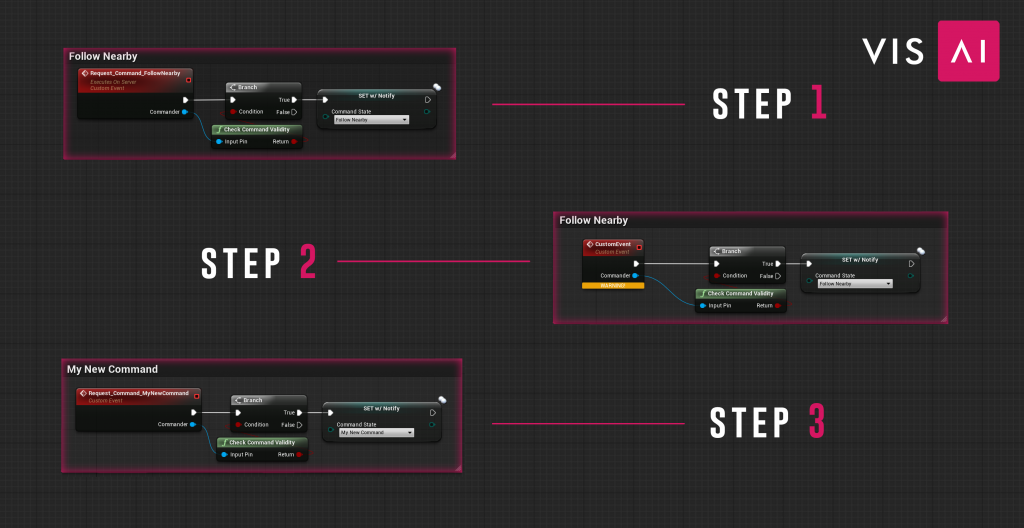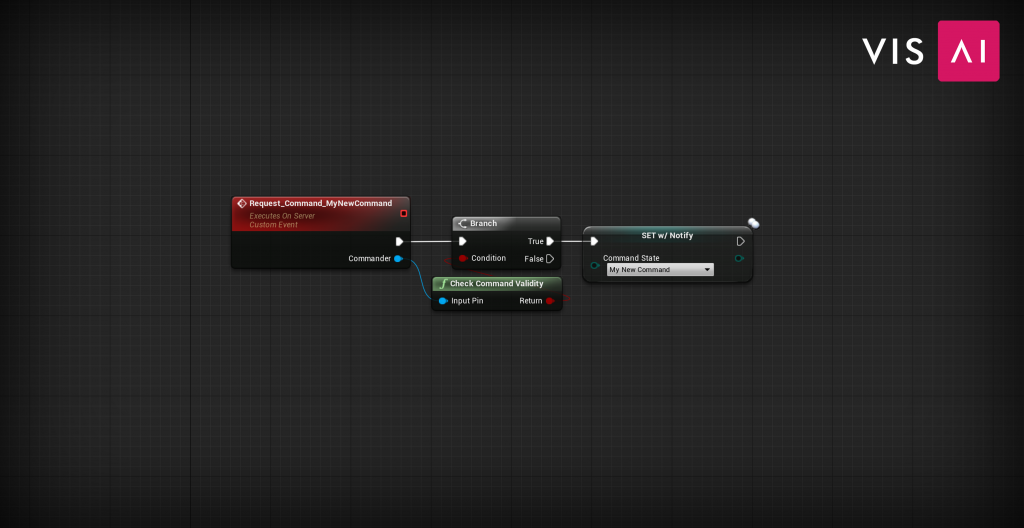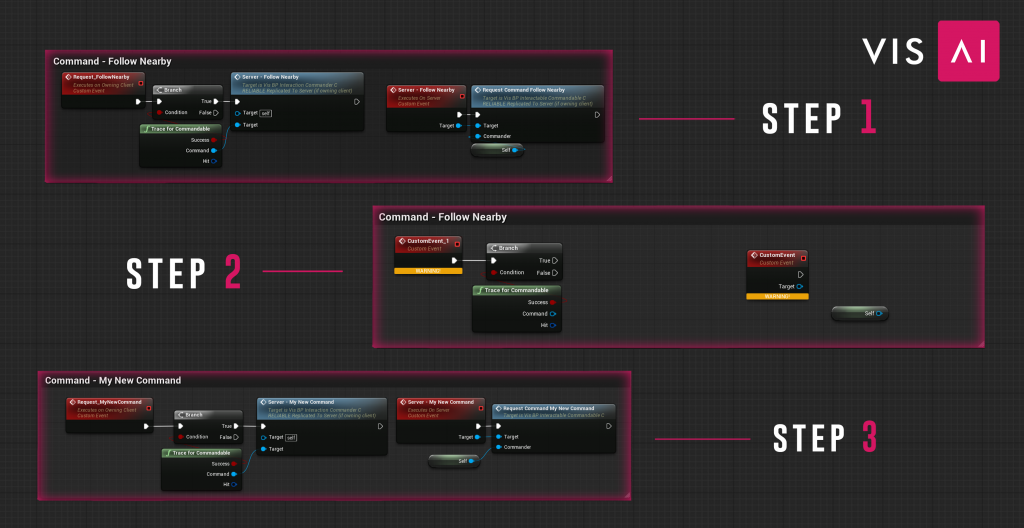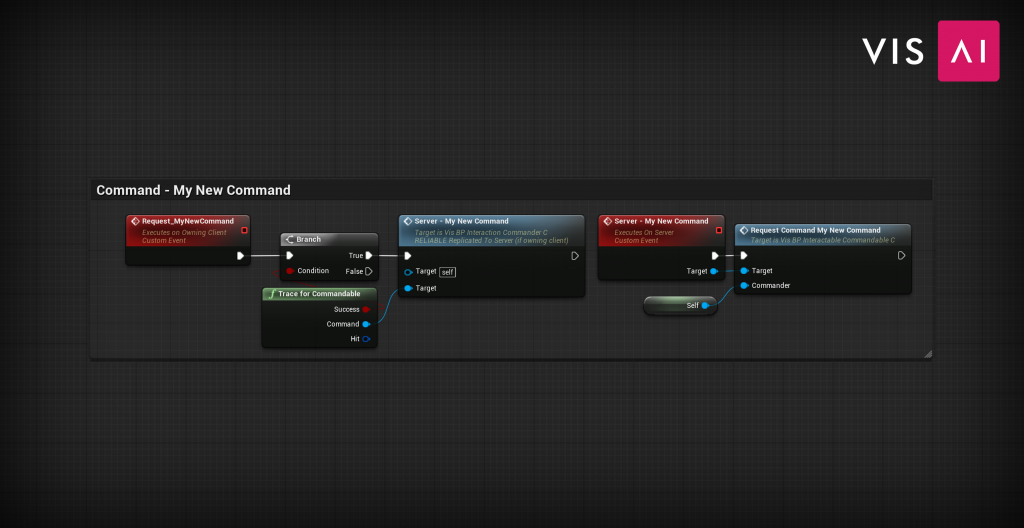
The Command System provides your players to give AI replicated commands, and makes the process as quick as possible. There are two types of commands available with the Command System by default. Set Commands, and Selection Commands.
Set Commands simply send a command to the AI.
Selection Commands allow your players to “Select” actors, interactables, or something else for a command.
For example, Follow Nearby is a Set Command, while Order To Position and Interact are Select Commands.

First things first, you’ll need to create the Behaviour, Decision, and Action for your command. If you’ve used VisAI before, it’s the same. If not, and you want to understand what you’re doing before you do it, you can find a full overview by visiting this link.
Step 1: Creating Behaviour
Step 2: Creating Decision
Step 3: Creating Action

Once you have your Behaviour, Decision, and Action setup, you’ll need to reference your command with the Command System.
Step 1: Locate the VisBP_Interaction_Command_Enum file
Step 2: Add an entry to the enumeration list, give it the display name of your Command

Commandable
The Commandable is responsible for receiving the command and any data needed for a command. Your AI references the Commandable to see if it should be following orders, and if so what it should be doing.
Step 1: Open the Commandable_C, locate the Command Graph and find the Set Commands section. Copy and Rename the “Follow Nearby” command as shown below, you’ll need all the nodes from it.

(If you need to pass any information for the command, you may do it in this event.)
Step 2: Set the value of the “Set w/ Notify” node for “Command State” to your new command’s name.
Step 3: Set your “Request” event to “Run on Server” & Reliable by selecting the event, and setting the “Replicates” variable. You can see the results below;

Commander
The Commander_C is responsible for providing any the data a command needs to the Commandable.
Step 1: Open the Commander_C, locate the Command Graph and find the Set Commands section. Copy and Rename the “Follow Nearby” command as shown below.

Now that you’ve copied the command, let’s take a moment to ensure its properly replicated.
Step 2: Set your “Request” event to “Run on Owning Client” & Reliable by selecting the event, and setting the “Replicates” variable.
Step 3: Set your “Server” event to “Run on Server” & Reliable by selecting the event, and setting the “Replicates” variable.
You can see the results below;

VisBP_FL_Command
Step 1: Open the VisBP_FL_Command Blueprint. Find the “Request Command” function
Step 2: On the “Switch on Command” node, you’ll see an unassigned execution line as shown below;

Step 3: Using the available “Requesting Commander” input, call the “Request” function for your command as shown below;

That’s it! Now that you’ve finished your Set Command, continue on to Adding a Hotkey or Adding Command to The Command UI to start using your command.

Adding a hotkey for your command is incredibly simple!
Open your Player Controller, and call the function “Get Commander C”. Use the Commander Reference to call the “Request” function for your command as shown below;


The process of adding a command to the Command UI has been streamlined for you. First, open the VisBP_CommandBox_UI.
Step 1: Inside the VisBP_CommandBox_UI, open the Widget Graph and find the map variable “Commands” in the variables list under the Settings category.
This variable includes all the commands available to your AI. It can be changed at runtime, as done in the Widget Initialization Graph, in order to change the Commands your players can use. In the future, this will be datatable based to provide a quicker route for customization.
Step 2: Add your Command to the list; the order of the commands *does* matter.
(Note: Due to a bug in the engine, you’ll need to remove the command with “No Orders” before adding your command, and then re-add the “No Orders” command afterwards.)

That’s it for Set Commands! If you haven’t learned about Selection Commands yet, visit this page here to get started.